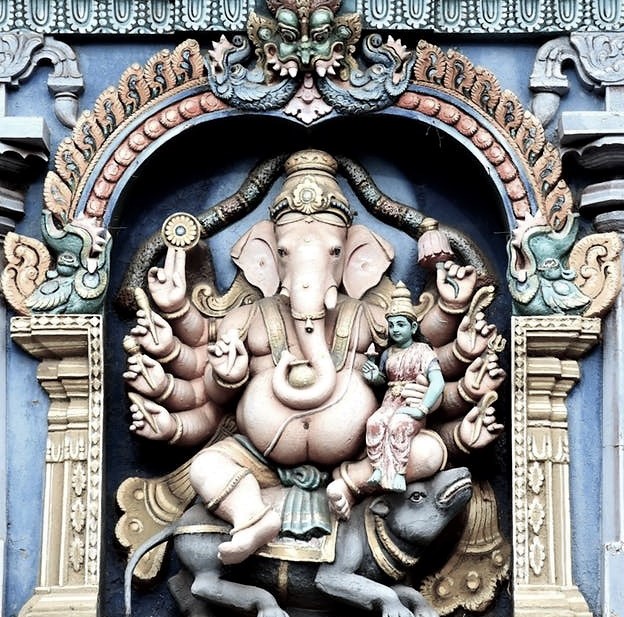- Special FeaturesFoundation YearSthala TreeTheerthamRathamArchitectureOther Speciality
- Sthala Puran
Kottiyoor Temple is a prominent Shiva temple in Kannur, Kerala. Vadakkeshwaram Temple is the common name of the temple from ancient times, but some of the local people address the temple as Ikkare Kottiyoor as it is on the bank of the river close to the Kottiyoor village, to differentiate it from the shrine in the other side of the river. Thruchherumana Kshetram is also another name by which temple is known. The temple is a special category temple under Malabar Devaswom board.[2]
There are two temples in Kottiyoor, one on the western bank of the Vavali river and the other one on the eastern bank of the Bavali river. The shrine on the east bank (Kizhakkeshwaram or Akkare Kottiyoor) is a temporary hermitage (Yaga shrine) opened only during the Kottiyoor Vysakha Mahotsavam. The Vadakkeshwaram or Ikkare Kottiyoor (The Thruchherumana Temple) on the western bank of the river is a permanent temple complex like all other temples. It remains closed throughout the year except for the 27 days of Vysakha festival. The temple is situated in a densely forested area amidst a sacred grove that covers about 80 acres. Mythology says that Akkare Kottiyoor, the shrine on the eastern bank of the river, was the location of Daksha Yaga, at the conclusion of which Sati Devi immolated herself and thus committed suicide in this place.
The Kottiyoor Perumal Temple was, in its heyday in terms of gold and precious stones, the second-wealthiest Temple in the entire Kerala region (second only to the Padmanabhaswamy Temple which even with its smaller five vaults opened, lays claim to the largest collection of gold and precious stones ever, as well as being the wealthiest place of worship in the world). Kottiyur Perumal's collection of gold and precious stones has been stored since time immemorial in the 'Karimbana Gopuram' of the "Ikkare Kottiyoor" Temple. Kottiyoor Perumal also owned over 30,000 acres of forest-lands in Kannur District.
The Thruchherumana Temple was built after the Swayambhoo lingam was found; however the exact date of construction of temple is not known; the pilgrimage has been taking place for many centuries.
- Architecture
- Alankar of Deity
- Prayers and BenefitsSpecial Vratas and Prayers
Present day rituals of Kottiyoor were set out by Sri Shankaracharya. With his spiritual vision, he felt the presence of Shiva at 'Akkare Kottiyoor' and not willing to pollute the holy ground with the touch of his feet, prayed from 'Ekkare Kottiyoor' and left.
Bamboo flower maker
The Vaisakha Maholsavam festival is held every year during the months of May - June. The twenty eight-day festival commences with the 'Neyyattam' ritual on the 'chodi' Day in Edavam (rishabham) and concludes with the Thrikkalashaattu. The Vaisakha Maholsavam celebrations begin with the ritual of bringing a sword from Muthirerikavu from Wayanad. On the following day, on Visakham star, Bhandaram Ezhunnallath ritual is held. Ornaments and Pooja vessels of pure gold and silver are brought from the nearby Manathana village to Kottiyoor.
The bridge
An important ritual during the festival is the 'Elaneer Vayppu' or submitting tender coconuts before the swayambhu Shiva linga. On this special day, thousands of tender coconuts carried from different parts of Kerala by the devotees are submitted. The following day, the Namboothiris of the temple collect water from tender coconuts in pure gold and silver pots and then the Chief Priest pours the collected coconut water on to the idol in what is known as 'Elaneeraattam', also called the 'Rashi velli'. Rohini Aaradhana is a very important ritual which is not seen in any other temple. Kurumathur Brahman (The senior most member of Kurumathur family considered as the embodiment of Vishnu in the ritual) embraces the swayambhu Shiva linga as part of the ritual. This is symbolic of Vishnu pacifying Shiva Who is saddened by the loss of Sati.
As a part of the festival, a procession (Ezhunnallippu) is held with two elephants carrying the idols of Shiva and Parvathi. After the procession, the elephants are fed well (Aanayootu) and given a formal farewell.
The 'Thammangadan Nambiar' Family (The Vediyara Chandrothu Family), a sub-branch of the Thiruvithamkur/Kolathiri Royal Family), used to (and still do) have by tradition, exclusive right to being the first to have their Ghee offered to the Deity for 'Abhishekam', during the "Naallam Thurakkal" ritual, at the Kottiyur Shiva Temple, believed to be the site for the famous Yajna of Daksha. "Villippalan Kurup" is the name, by which the member of this Family, performing the ghee-offering ritual is known.
Offerings to DeityStotras and Mantras
- Festivals
- Sodasha Upcharas
- Prasadhas
- Social ActivitiesAnnadhanMarriageEar BoringHead ShaveDanaasEducation FacilitiesSocial DrivesOther Activities
- Arjita Seva
- Tags

